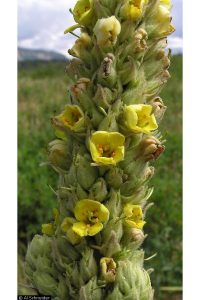Mullein
(Verbascum thapsus)
- Alias names for Mullein: Verbascum Thapsus, Family: Scrophulariaceae, Aaron’s Rod, Lady’s Foxglove, Donkey’s Ears, Bunny’s Ears, Candlewick, Feltwort, Flannel Leaf, Jacob’s Staff, Lungwort, Velvet Dock
- Chinese Names for Mullein: None found
Pictures of Mullein:
(Note: Poisonous look alike plant is Fox Glove or Digitalis which is toxic See this link for a picture of Digitalis https://en.wikipedia.org/wiki/Digitalis )
References for Mullein pictures:
- https://www.nps.gov/plants/alien/fact/veth1.htm
- https://plants.usda.gov/java/profile?symbol=VETH&photoID=veth_013_ahp.tif
- https://www.cas.vanderbilt.edu/bioimages/species/veth.htm
- www.ct-botanical-society.org/galleries/verbas…
About Mullein: Mullein is a biennial that grows upright to 6 feet tall. The furry leaves form a rosette that alternate and overlap each other. Mullein leaves are large, grayish-green, and lance shaped. Bright yellow flowers bloom along the single spike that comes from the center of the plant. Each flower has five petals. In the fall the flowers turn into seed pods that contain thousands of tiny seeds. The Mullein plant is native to Europe and Asia but now grows in many other temperate parts of the world including the United States. Mullein can grow just about anywhere, especially waste lands and gravel-like soil areas. You have probably seen it along roadsides or construction areas. Leaves are harvested in the late spring to summer. The flowers are collected during dry weather and need to be dried immediately. They lose the effectiveness if they get wet and turn brown.
Actions and Historical Uses of Mullein:
- Aids virus
- Anemia
- Arthritis
- Asthma
- Bronchitis
- Bruises
- Colds
- Cough
- Diaper rash
- Diarrhea
- Earache
- Enlarged prostate
- Gas
- Glandular swelling
- Hay fever
- Hemorrhoids
- Insomnia
- Laxative
- Lymphatic system
- Nerves
- Pain
- Panic attacks
- Pneumonia
- Respiratory system
- Sinus problem
- Sore throat
- Swollen joints
- Tonsillitis
- Tuberculosis
- Tumors
- Urinary tract infection
- Venereal diseases
- Warts
How Mullein is used and how it Works:
Mullein soothes, lubricates, and tones the respiratory system and aides in expectoration by stimulating fluid production. Mullein is sometimes used with other herbs such as white horehound, lobelia, elder, and red clover. The iridoid glycosides stimulate secretion of uric acid from the kidneys.
- Mullein leaves and/or flowers for infusion tea for respiratory disorders
- Mullein infused oil from flowers for ear infections, hemorrhoids, and skin disorders
- Mullein leaf poultice applied to topical boils, sores, ulcers and tumors
- Mullein tea from fresh chopped leaves filtered through a coffee filter provide a variety of vitamins and other nutrients
- Mullein compress to relieve swelling
- Crushed flowers to remove warts
- Mullein tincture
- Dry mullein leaves smoked for respiratory problems
Parts of the Mullein Plant Used: Leaves and flowers
Properties of Mullein: Analgesic, antiseptic, bitter, cold remedy, cool, demulcent, dermatological aid, diuretic, ear medicine, emollient, expectorant, gastrointestinal aid, respiratory aid, sedative, tonic.
Chemical Constituents of Mullein: Catalpol, coumarin, crocetin, flavonoids, hesperidin, iridoid glycosides, mucilage rotenone, saponins, tannins, thapsic-acid, triterpenoid saponins, verbascoside, verbasterol, volatile oil
Contraindications, safety issues, concerns, harmful drug interactions and allergy precautions for Mullein: Mullein is generally a safe herb to use even during pregnancy and nursing. There have been reports of skin irritation, mostly from the tiny hairs that cover all parts of the plant except the roots. The diuretic actions of mullein may cause drug interactions with analgesics, hypoglycemic drugs, and corticosteroids. The narcotic nature of mullein seeds are toxic and have been use to stun fish. Do not put mullein oil or anything in an ear that has a ruptured eardrum. Have a licensed practitioner do an ear examination first.
Helpful Links and References for Mullein:
- https://www.altnature.com/gallery/mullien.htm
- https://www.ashtreepublishing.com/Book_City_Herbal_Mullen.htm
- https://www.herbcraft.org/mullein.html
- https://botanical.com/botanical/mgmh/m/mulgre63.html
- Workshop handout from Darcy Williamson https://www.darcyfromtheforest.com/servlet/StoreFront
- Do Herbs by Sandy Brooks (Book)
These products are not drugs, but foods for special dietary use pursuant to applicable Federal law. No statement in this page shall be construed as offering these products for the diagnosis, cure, mitigation, treatment, or prevention of any disease.
Related Pages:


